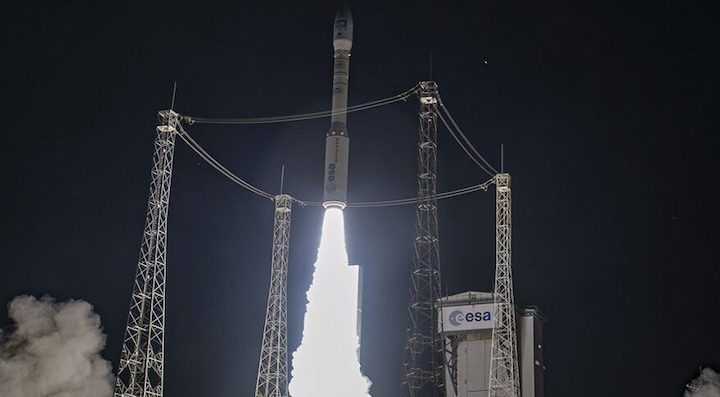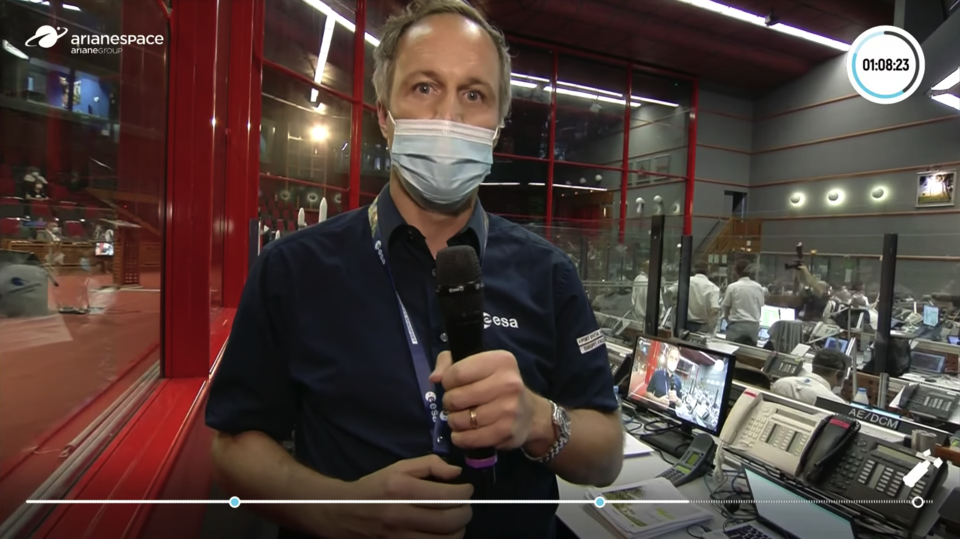29.04.2021

TAMPA, Fla. — Europe’s small launch vehicle Vega returned to flight April 28, carrying a next-generation imaging satellite for Airbus Defence and Space that has been held back by multiple delays.
Arianespace successfully launched the rocket 9:50 p.m. Eastern from the Guiana Space Center.
Pleiades Neo 3, the first high-resolution 30-centimeter satellite in a new constellation built and operated by Airbus, was released from the rocket in a mission that lasted one hour and 42 minutes following takeoff.
Five auxiliary payloads were on the rocket’s Small Spacecraft Mission Service (SSMS) deployment system: Norwegian space agency’s Norsat-3 observation microsatellite and four cubesats for Eutelsat, NanoAvionics/Aurora Insight and Spire.
It is Vega’s first mission since a Nov.16 launch failure destroyed two Earth observation satellites: Spanish operator Hisdesat’s SEOSAT-Ingenio and the TARANIS spacecraft built by French Space Agency CNES.
An independent investigation pinned the failure on cables that were improperly connected in the upper stage of the rocket, which Italian rocket maker Avio builds.
The need to review that failure added about two more months of delay for the first satellite in Airbus’ Pleiades Neo constellation.
The inaugural spacecraft had been slated to launch on the upgraded Vega C rocket in 2020.
However, Airbus shifted gears after the debut flight for Vega C was pushed into mid-2021, following a separate Vega launch failure in July 2019. That failure destroyed the FalconEye1 imaging satellite for the United Arab Emirates and was blamed on a structural failure in the rocket’s solid-fuel second stage.
30-centimeter duopoly
Pleiades Neo 3 is the first in a constellation of four identical imaging satellites.
A second spacecraft is slated to launch in July, and two more are set to be lofted on a single Vega C rocket in the first half of 2022.
The full constellation will be able to visit any point on Earth at least twice a day, supplementing the lower resolution optical — and synthetic-aperture radar (SAR) — spacecraft that Airbus also operates.
Five years in the making, it is the company’s biggest 100% self-funded program in space and defense, Airbus Defence and Space head of intelligence Francois Lombard told SpaceNews in a pre-launch interview.
Up until now, Lombard said only U.S.-based Maxar Technologies has been offering commercial customers 30-centimeter resolution imaging with its WorldView constellation.
Pleiades Neo will be Airbus’ workhorse imagery constellation for the next 10-12 years.
Lombard said the company’s bet on four identical satellites underlines its confidence in the market’s direction toward higher resolution imagery.
“We will grab a big part of this market,” he said.
“Our expectation is that it is a market that will continue to grow.”
He pointed to how the company’s commercial traction is already validating this approach. Usually, satellite customers wait to see how a spacecraft operates in orbit before making commitments, but Lombard said the company had racked up agreements worth “hundreds of millions” in 2019.
“Here I can say we benefit from the long relationship [and] trust in the Airbus technology,” he said, pointing to the advantage the company has in controlling the spacecraft from end-to-end.
Reversing a historic dynamic for the industry, these pre-launch customers are more on the commercial side of the market, he added, while the government segment has been conservative and will be more of a “second step complement.”
A company in China has signed up for the service, Lombard said in an April 29 media briefing, and it also has “some contracts” in the U.S.
He put the total investment for the Pleiades Neo program at around €600 million to €700 million ($723 million to $848 million).
Maxar, which also builds satellites in-house, plans to launch the first two spacecraft in its next-generation $600 million Worldview Legion constellation in September.
Four more WorldView Legion satellites are slated to launch about three to six months later.
The WorldView Legion constellation, which Maxar expects will triple its ability to collect 30-centimeter-resolution optical imagery, are set to launch on SpaceX Falcon 9 rockets.
Before the COVID-19 pandemic, Maxar had planned to start launching WorldView Legion satellites in the first quarter of 2021.
Quelle: SN
+++
Vega’s first launch this year
Liftoff of Vega from Europe’s Spaceport in French Guiana came at 02:50 BST on 29 April (03:50 CEST; 22:50 local time on 28 April) to deliver Pléiades Neo-3 and five auxiliary payloads into their respective orbits.
On this flight, Vega made use of part of its ESA-developed Small Spacecraft Mission Service (SSMS) multiple payload adapter. The SSMS is a modular lightweight carbon-fibre structure, which can accommodate multiple light satellites with a mass of 1–500 kg.
The flexibility of the SSMS system allows spare capacity on Vega to be used to launch small satellites piggyback to the main customer payload. Using more than one burn of the upper stage means that they can be delivered into different orbits too.
Europe’s first use of the SSMS was a rideshare mission in September last year, carrying 53 small satellites. This demonstrated Vega’s new service to offer affordable routine access to space for multiple light satellites.
With a liftoff mass of 920 kg, Earth observation satellite Pléiades Neo-3 was the first to be released into its target Sun-synchronous orbit about 54 minutes into the mission.
This was followed about 47 minutes later by the coordinated release of Norway’s Norsat-3 microsatellite and four CubeSats: Bravo, two Lemur-2 satellites and Tyvak-128A.
Complying with debris regulations to help keep space clean, Vega’s upper stage fired a final time to ensure direct reentry and burn up high in the atmosphere over the ocean.
The Vega launch system is Europe’s way of launching light satellites to multiple orbits in a single launch. Following the loss of Vega’s previous mission, flight VV17, an Independent Inquiry Commission appointed by Arianespace and ESA, formulated a road map for a robust Vega return to flight.

Avio, industrial prime contractor for the Vega launcher, under the direction of Arianespace and ESA followed all recommendations on launch vehicle production and launch preparations. Today’s flight VV18, represents a successful return to operations of Vega.
“I’m pleased to see Vega is back in business and thank our teams in ESA, together with Arianespace, Avio and suppliers for their hard work to arrive at this point. This flight shows Vega’s versatility. It delivered one main satellite and made use of spare capacity to deploy five additional satellites to a separate orbit,” commented Daniel Neuenschwander, Director of Space Transportation at ESA.
Quelle: ESA
